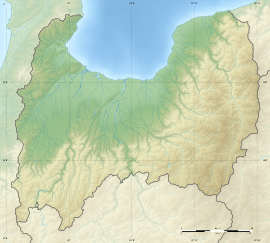Yanaidanu-no-Oyama Kofun
Yanaidanu-no-Oyama Kofun (柳田布尾山古墳) is a keyhole-shaped kofun burial mound located in the Yanaida neighborhood of the city of Himi, Toyama in the Hokuriku region of Japan. It has been protected by the central government as a National Historic Site since 2001.[1]
柳田布尾山古墳 | |
 | |
 Yanaidanu-no-Oyama  Yanaidanu-no-Oyama Kofun (Japan) | |
| Location | Himi, Toyama, Japan |
|---|---|
| Region | Hokuriku region |
| Coordinates | 36°49′24″N 136°59′27″E |
| Type | kofun |
| History | |
| Founded | late 4th or early 5th century AD |
| Site notes | |
| Excavation dates | 1998-2001 |
| Ownership | National Historic Site |
| Public access | Yes |
Outline
The Yanaidanu-no-Oyama Kofun is located in the northwest part of Toyama prefecture, near the eastern base of Noto Peninsula and near the shore of Toyama Bay, at an altitude of approximately 25 meters above sea level. With a length of 107.5 meters, it is the largest keyhole-shaped tumulus in Toyama Prefecture, and the 10th largest in the country. It was discovered only in 1998, and was excavated from 1998-2001. No haniwa or fukiishi were discovered on the kofun, which was found to have been robbed at some time in antiquity. The time of its construction is estimated to date from the end of the 3rd to the late 4th century, and there is no indication of who was buried in this tomb. The area is now open to the public as part of an archaeological park.
- Total length: 107.5 meters
- Main Portion: 2-stages, 54 meter length x 53 meter width x 10 meter height
- Keyway Portion: 2-stages, 53.5 meter length x 49 meter width x 6 meter height
The tumulus was constructed by partly cutting away the round on a narrow terrace, such that the embankment volume is about 60% of the total volume of the tumulus. The tumulus was surrounded by a amorphous moat measuring 5 to 18 meters wide and 1.2 to 1.2 meters deep. The tomb appears to be built on the site of a Yayoi period settlement, as pottery from that period has been found in the area.
There is a smaller (25 meter diameter) circular tumulus surrounded by a five-meter wide and 1.6 meter deep moat is located on the eastern rear side of the tomb. Details of its construction are unknown as it has not been excavated: however, from the details of its construction, there is a possibility that it predates the keyhole-shaped tomb.
References
- "柳田布尾山古墳". Cultural Heritage Online (in Japanese). Agency for Cultural Affairs. Retrieved 25 December 2017.
External links
| Wikimedia Commons has media related to Yanaida Nunooyama Kofun. |
- Toyama Tourist Information (in Japanese)
- Himi City official site (in Japanese)